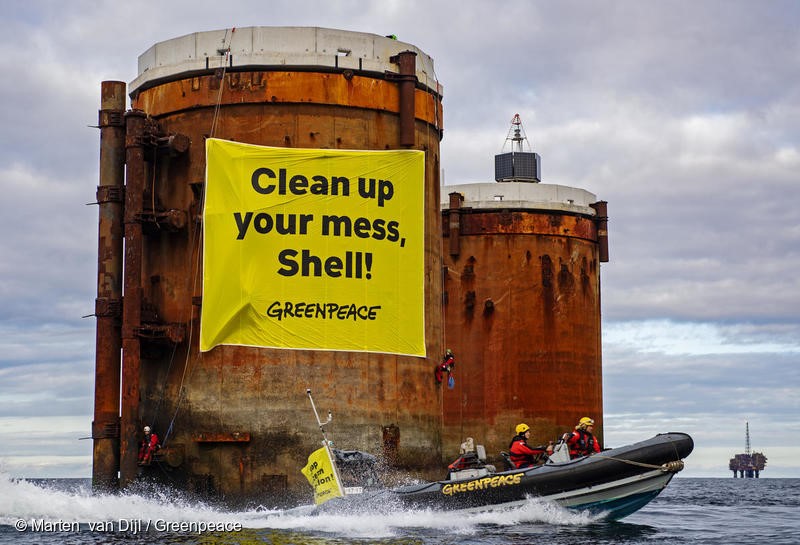This story is the start of The North Sea Investigations, a multi-year international reporting project on the battle for the future of the North Sea, led by Dutch investigative journalism platform Follow the Money in cooperation with Norwegian broadcaster NRK, Belgian newspaper De Tijd and DeSmog.
Skimming across the waves in inflatable dinghies, activists closed in on their target: An abandoned steel hulk looming 40 storeys above the surface of the North Sea. Encircling the platform, tugboats fired plumes of seawater in a spectacular but futile attempt to stop the protesters scaling its sheer sides.
It was the spring of 1995, and a Greenpeace campaign to prevent Royal Dutch Shell disposing of the giant floating oil tank — known as Brent Spar — by towing it away and sinking it was fast developing into a pivotal moment in environmental activism. Shell had never faced anything like it. The activists occupied the facility for nearly a month; British opposition politicians rallied to their cause; and customers boycotted Shell petrol stations in the Netherlands and Germany. In Hamburg, a Shell service station was firebombed.
Although Shell and UK regulators agreed that sending Brent Spar to the bottom would cause little environmental harm, the outcry forced the company to abandon the plan. The storage buoy was eventually towed to Norway and repurposed as part of a quay.
While the battle over Brent Spar has long since faded from the headlines, the dilemmas posed by derelict North Sea oil and gas facilities have never been more pressing.
An international research team led by Dutch investigative journalism platform Follow the Money has found that governments and companies are falling behind in their obligations to dismantle and remove obsolete oil and gas installations — threatening to turn the North Sea into a vast graveyard of decaying fossil fuel infrastructure.
The oil industry’s failure to clean up after itself poses enormous environmental risks. Hundreds of drilling rigs; thousands of oil and gas wells; and tens of thousands of kilometers of pipelines occupy vast stretches of this unique habitat. This sprawling legacy leaches oil, chemicals, plastics and other contaminants as the relentless action of waves and currents inexorably wears human traces away.
The slow pace of the cleanup saves the fossil fuel industry money in the short term. But it also serves the sector’s long-term commercial interests. Obsolete oil and gas infrastructure could give its owners a head start in a region rapidly emerging as a basin for wind farms; hydrogen hubs; and plans to capture carbon dioxide (CO2) from northern Europe’s smokestacks and bury it under the sea.
What might seem like a vast expanse of empty water is in fact one of the world’s busiest shipping lanes. While the North Sea is playing a growing role in the energy transition, it remains a vital transport corridor; a source of sand for the construction industry; a fishery; and a unique habitat for wildlife.
Opaque Picture
Oil and gas operators are required to dismantle facilities at the end of their useful life under the terms of a marine life convention known as Ospar, signed by 15 countries and the European Union. That includes tearing down structures above and below water; permanently sealing wells with cement plugs; and flushing out buried pipelines.
So far, this kind of cleanup has not happened on anything like the scale it should have, according to mapping by Follow The Money.
Existing data suggests many wells are already out of service, with some 10 percent of oil and gas platforms, and a fifth of pipelines, no longer active. But with records dispersed between different agencies, companies, governments and regulators, nobody has a comprehensive overview. Definitions of “out of use” differ, and many pipelines registered as “removed” are in fact still intact, confusing the picture further.
Hoping to gain more clarity, the Netherlands tightened reporting rules in January 2022 to require operators to notify authorities within four weeks of a well going inactive. Prior to that, wells could lie dormant for years without any report being filed, according to the Dutch Ministry of Economic Affairs and Climate. The ministry also says it has little visibility on what infrastructure is about to be retired.
“[We have] no insight into plants that will be taken out of operation this year or in the coming years, this depends, for example, on the duration of production,” a ministry spokesman said in an email.
The Dutch regulator, the State Supervision of Mines, says the number of decommissioned wells is “increasing daily.” “We do not keep a current count,” a spokesman for the regulator said.
The lack of data does not surprise Jip van Zoonen, consultant and project leader for North Sea permits at Rijkswaterstaat, the Dutch executive agency of the Ministry of Infrastructure and Water Management. Requirements to register cables and pipelines were only introduced 20 years ago — long after industry began to exploit the seabed.
“Cables have been laid in the Dutch part of the North Sea since the mid-nineteenth century, but not all of them are fully registered,” van Zoonen said. “People also do not always know exactly where they are all located, and to whom they belong.”
Even as the cleanup job gets bigger by the day, many seabed installations have yet to appear in the decommissioning plans of the various North Sea countries, Follow The Money found.
Costs To The Taxpayer
What is clear is that taxpayers will be footing a large share of the bill. In the Netherlands, the government picks up about 73 percent of cleanup costs. In Norway, the share is 78 percent, and in the UK it is 40-75 percent, depending on tax arrangements with the operators.
In 2021, the European Commission estimated the combined costs of cleanup work in the North Sea at 30 billion euros between 2020-30. The cost breaks down as follows:
- UK: 17 billion euros.
- Norway: 9.7 billion euros
- Netherlands: 2.6 billion euros
- Denmark: 0.5 billion euros
Even after 2030, countless more wells, platforms and installations will still have to be decommissioned, pushing total costs higher.
- The Dutch government estimates total cleanup costs in the Netherlands at 4.5 billion euros.
- The Netherlands will be liable for a further four billion euros if all pipelines have to be removed.
- Total costs facing the UK run to £44.5 billion, according to Britain’s North Sea Transition Authority regulator.
Even these figures could be a significant underestimate. A study published in March 2021 shows that cleanup costs in the North Sea are on average 76 percent higher than initial estimates.
“The costs can be staggering,” said Chris Lehouck, chief executive of Deco Subsea, one of the largest cleanup companies in Belgium. “Sometimes there are nasty surprises, such as underwater structures overgrown with rock hard cauliflower or a thick shell crust.”
Reasons To Delay
With costs so significant, governments and companies have every incentive to postpone the task of dismantling infrastructure for as long as possible.
“It’s true that people don’t always have much appetite for decommissioning,” Lehouck said. “It’s a down payment on a death warrant: Nobody likes to make it. But we have seen in the past few years that efforts are increasing.”
In the Netherlands, operators must submit a disposal plan a year after a facility ceases production. But applications for exemptions submitted to the Ministry of Economic Affairs and Climate show that operators can drag the process out for years by arguing that it would be more economical to wait for the opportunity to decommission several platforms at a time.
Operators can also win exemptions by indicating that they may want to reuse an installation in the future — such as by repurposing pipelines to transport hydrogen, or using gas or oil fields to store CO2 captured from industry.
Last year, the Netherlands granted French major TotalEnergies; London-based Neptune Energy; Dutch oil and gas producer ONE-Dyas; and Abu Dhabi energy company TAQA extensions on their decommissioning obligations to explore options for CO2 storage, among other activities, according to a Follow The Money review of official records. Six projects for CO2 storage are currently underway in the United Kingdom, involving companies such as BP, Equinor and Harbour Energy. The UK’s North Sea Transition Authority (NSTA) says there are 26 more such projects planned.
“NSTA is committed to helping the industry make decommissioning and repurposing a vital part of the UK’s energy transition,” said Pauline Innes, head of decommissioning at NSTA. “Repurposing not only makes financial-economic sense, but is also good for the environment.”
NSTA and and oil companies have identified 100 pipelines that could potentially be used to serve a low-carbon economy. Repurposing only half of these would save the equivalent of £7 billion that would otherwise have to be spent on new pipelines, and an additional sum in decommissioning costs, NSTA says.
Follow The Money has calculated that delaying decommissioning indefinitely would save oil companies a total of 10-15 billion euros of cleanup liabilities shared between the UK, Norway and Netherlands. That figure is a fraction of what governments may still have to pay, but still a significant windfall for operators with significant exposure to platforms and wells, such as BP, Equinor, Shell, TotalEnergies and the UK’s Harbour Energy.
Data reviewed by Follow The Money shows that Shell does not hold many abandoned platforms, but it does operate most of the inactive pipelines. BP and Equinor also have dormant infrastructure and are exploring ways to use it to store CO2, or for hydrogen.
Leaving obsolete infrastructure in place provides a double benefit to the oil industry: Companies avoid cleanup costs and secure a central role in the offshore energy transition that could be worth billions in future profits and subsidies .
Environmental Risks
If cleanup costs are hard to estimate with confidence, the scale of the environmental risks are even more difficult to quantify.
When inactive wells are not properly plugged, they can leak natural gas, which is mostly comprised of methane, a powerful climate pollutant. Poorly cleaned oil pipelines can seep residues into the sea.
Some scientists argue that it would cause less harm to leave most of the drilling infrastructure standing. The giant legs of oil platforms serve as artificial reefs, encrusted with mussel and oyster beds, while superstructures provide isolated breeding grounds for seabirds. Digging them up, cutting them apart and dragging them away would only further disrupt seafloor life, the argument goes.
Filip Volckaert, a professor of evolutionary and marine biology at Belgian university KU Leuven, dismisses that argument, saying the long term harm caused by leaving the infrastructure to decompose outweighs any temporary damage from dismantling the platforms.
“Leaving everything behind in the sea creates much greater ecological pressure,” Volckaert said. “Even if certain species benefit from the structures left behind…in the end, we are left with a lesser quality of biodiversity.”
Dutch regulator SSM sometimes orders the removal of an entire installation on environmental grounds. For example, in one case the regulator found that Abu Dhabi’s TAQA had not demonstrated that there would be no “adverse undesirable environmental risks” to leaving pipelines in place. Moreover, the pipelines were located in an area where there were many “sand waves,” which could expose the pipes and cause fishing nets to snag, the regulator found.
Test Case
While Brent Spar focused global attention on the fate of redundant North Sea infrastructure almost two decades ago, Shell is now providing a test case for future policy.
The company is seeking permission from the UK government to leave three giant concrete supports known as Brent Bravo, Brent Charlie and Brent Delta, each one weighing more than 300,000 tonnes, on the seafloor. Once again, Greenpeace opposes Shell’s plan, arguing that the Eiffel Tower-sized structures still contain some 11,000 tons of oil that will leach into the sea as the steel legs and concrete foundations erode.
Shell has concluded that removing the structures and collecting, transporting and disposing of the oil would cause more damage than the “minimal” impact of leaving them in place. The company argues that the oil is encased in concrete that will take “centuries” to degrade.
“We came to the conclusion that leaving the oil in place would be the right thing to do,” Duncan Manning, Shell’s asset manager for the Brent field, said in 2017.
Similarly, in Norway, Equinor plans to leave all the concrete of the so-called Statfjord A structure — totalling more than 300,000 tons of material — on the seabed.
“We understand that Greenpeace is concerned about the possible environmental consequences, and so are we,” said Equinor spokesperson Gisle Ledel Johannessen. “We plan for this to take place in a responsible manner and in accordance with the authorities’ requirements.”
Ospar countries are due to decide the fate of Shell’s Brent structures next year — setting an important precedent for the future of the basin.
The United Kingdom, which has the biggest share of North Sea oil and gas facilities, is keen to take advantage of Ospar provisions that allow for retired assets to stay in place in exceptional circumstances, eyeing future roles for the platforms in carbon capture or other projects.
Belgium and Germany, who have a fraction of the UK’s exposure, want to stick to the spirit of the agreement and see all obsolete structures properly removed.
Belgian North Sea Minister Vincent Van Quickenborne said countries were too quick to grant a waiver for dismantling installations containing huge amounts of concrete, metal, plastic, oils and other harmful substances that will eventually leach into the sea. The space taken up by such platforms could be better utilized, he argued.
“Cost and feasibility arguments are invoked too quickly,” Van Quickenborne told the Follow The Money-led research team. “That should not be an argument in this case.”
Subscribe to our newsletter
Stay up to date with DeSmog news and alerts






